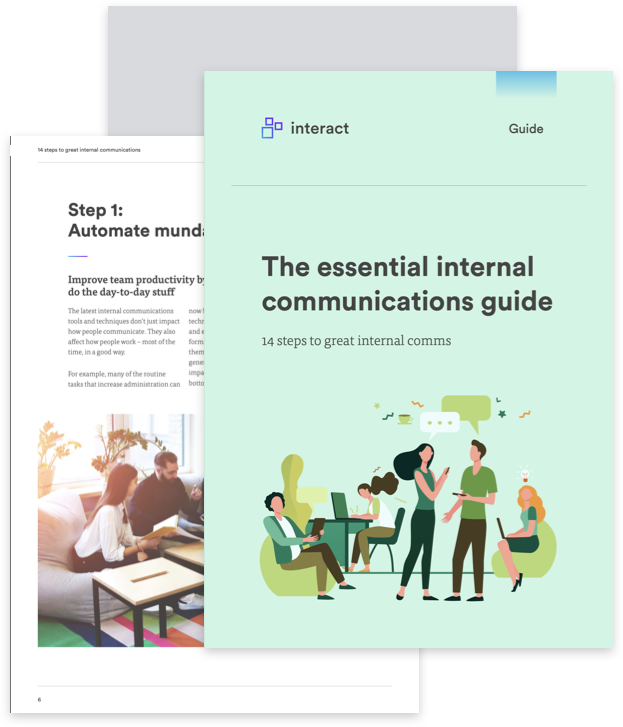Discover the benefits of internal PR, real-world examples, and how modern intranet software can support it.
Internal PR serves as a bridge between internal communications, marketing, and PR, enabling organizations to align their messaging, engage employees, and strengthen their overall brand reputation. By recognizing the value of internal PR and integrating it into their communication strategies, companies can create a more informed, engaged, and connected workforce, leading to improved employee satisfaction, enhanced productivity, and a positive corporate culture.
How do internal comms and internal PR differ?
While internal communication encompasses all the activities an organization uses to communicate with its employees, including HR messaging, policies, and news, internal PR is a type of internal communication that focuses more on how employees perceive the organization. It involves building positive relationships between the organization and its employees, promoting values, goals, and culture to its internal audience, and managing the internal reputation.
When do you need internal PR?
A company may need to implement internal PR strategies for several reasons.
For example, during periods of significant change, such as mergers & acquisitions, restructurings, or leadership transitions, internal PR can play a vital role.
When employee engagement and morale are low, an effective internal PR campaign can help uplift and motivate the workforce. By implementing strategies that involve frequent and transparent communication, recognition programs, and opportunities for employee feedback, you can build a positive work culture that boosts morale and enhances employee satisfaction.
In times of crisis or when sensitive issues arise, internal PR is crucial for managing internal communications. It ensures accurate information reaches employees promptly, addresses their concerns, and keeps them informed about the company’s actions and progress. By maintaining open lines of communication, internal PR helps manage the narrative, mitigates reputational damage, and maintains employee trust and loyalty.
14 steps to great internal communications
Internal PR also becomes necessary when companies need to align their employees’ actions and behaviors with the organization’s goals and values. By effectively communicating the company’s vision, objectives, and strategic direction, internal PR ensures that employees understand their roles in achieving organizational success. This alignment enhances employee motivation, collaboration, and a sense of shared purpose.
Internal PR can play a pivotal role in shaping and nurturing a strong corporate culture. From simply naming your intranet to reflect your internal brand, to regularly sharing success stories, highlighting employee achievements, and promoting values and initiatives, you can reinforce the desired culture and fosters a sense of community, loyalty, and pride among employees. This contributes to higher employee retention, attraction of top talent, and a positive internal brand.
7 real-world internal PR examples from major brands
When companies want to enhance their brand reputation and amplify their messages, internal PR is useful for engaging and informing employees so they can become powerful brand advocates.

Zappos’ culture book
Zappos, the online shoe and clothing retailer renowned for its exceptional customer service, implemented an internal PR strategy centered around its renowned “Culture Book“. It serves as a powerful internal PR tool, fostering a sense of community, pride, and engagement among employees by showcasing their voices and contributions. By giving employees a platform to share their experiences, Zappos reinforces its commitment to transparency, inclusivity, and employee empowerment.
HubSpot’s internal podcasts
It seems that everyone is launching podcasts nowadays, and it’s hardly surprising given the appetite for the format. According to Edison Research, the average listener consumes nine podcast episodes per week. Recognizing their appeal, HubSpot began producing internal podcasts as a creative and engaging way to communicate important company updates, industry trends, and thought leadership content.
These podcasts not only inform employees but also entertain and inspire them, resulting in a more connected and informed workforce.
Sony Interactive Entertainment makes employees part of the action
When employee surveys showed that staff at Sony Interactive Entertainment felt out of the loop, the company responded by creating a social intranet built on Interact’s software.
Packed with a combination of inspirational ideas, fun content, and business-essential information, the intranet is also a PR resource that includes the live streaming of company events to help employees feel included and informed.
14 steps to great internal communications
AllianceBernstein’s meaningful internal PR initiative
Interact customer AllianceBernstein recognizes the value of an inclusive workplace.
To help AllianceBernstein speak positively with all employees, the company implemented strategic initiatives including employee resource groups, such as the Women’s Leadership Initiative and the Black Employee Network to provide support, networking opportunities, and mentorship.
Additionally, they implemented unconscious bias training for all employees and revised recruitment and promotion processes to ensure fairness and diversity. The company has since been recognized as one of the best places to work for LGBTQ+ equality.
Uber’s culture crisis
Uber faced a series of controversies related to workplace culture, ethics, and leadership in 2017. To address these issues, the company embarked on a comprehensive internal PR campaign aimed at improving workplace culture and rebuilding trust.
They conducted internal investigations, made leadership changes, and communicated transparently with employees about the actions being taken. Uber implemented listening sessions, employee surveys, and regular internal communications to ensure that employees felt heard, supported, and aware of the company’s commitment to change.
Internal PR at an automotive giant
When Volkswagen faced challenges around emissions in 2015, internal (as well as external) PR became crucial. Volkswagen had to address the issue internally, communicate with employees, and manage the fallout.
They launched an internal PR campaign to maintain transparency, rebuild trust, and engage employees in the process of rectifying the situation. Regular internal communications, town hall meetings, and transparent updates helped manage employee concerns and ensure they felt informed and involved in the company’s recovery efforts.
United Airlines’ passenger incident
In 2017, United Airlines faced public scrutiny after a video went viral showing a passenger being forcibly removed from an overbooked flight. United Airlines responded by implementing internal PR strategies to address the incident and its impact on employee morale. The company’s CEO issued public apologies, communicated with employees about policy changes, and conducted internal training to improve customer service and conflict resolution.
How intranet software facilitates internal PR

Internal PR can take many forms, and it can require engagement from many different segments of an organization’s workforce. Intranet software is a common example of a technology that serves as a powerful tool for internal PR due to its ability to facilitate effective communication, engagement, and information sharing within an organization:
Centralized information hub
An intranet provides a centralized location for employees to access important company information, news, updates, and resources. It serves as a go-to source for internal PR initiatives, ensuring that employees have easy and consistent access to relevant communications.
Targeted messaging and segmentation
Intranets allow for targeted messaging based on departments, teams, or employee roles. This multichannel segmentation enables you to tailor your communication and content to specific audiences, ensuring relevance and increasing engagement.
14 steps to great internal communications
Real-time updates
With an intranet, internal PR can deliver real-time updates and announcements to employees. This ensures that employees are always informed about the latest news and events, creating a sense of immediacy and reducing the risk of misinformation or outdated information.
Interactive and engaging content
An intranet provides opportunities to create interactive and engaging content that goes beyond traditional text-based communications. Videos, podcasts, images, surveys, polls, and discussion forums can all enhance employee engagement and participation.
Two-way communication
An intranet enables two-way communication between employer and employee. Employees can provide feedback, ask questions, and engage in discussions, fostering a sense of inclusiveness and collaboration. This feedback loop allows you to understand employee sentiments, address concerns, and refine communication strategies accordingly.
Employee collaboration and knowledge sharing
Intranets often include collaboration tools such as document sharing, project management, and team collaboration spaces. These features facilitate knowledge sharing, cross-departmental collaboration, and idea exchange, all of which contribute to a culture of transparency and innovation within the organization.
Measurement and analytics
Intranets provide data and analytics capabilities that allow you to track engagement, content performance, and employee interactions. This data-driven approach helps assess the effectiveness of internal PR initiatives, identify areas for improvement, and make data-backed decisions.
Accessible any time, anywhere
Intranets can be accessed by employees regardless of their location or time zone, making them ideal for reaching a dispersed or remote workforce. This accessibility ensures that all employees, regardless of their physical location, can receive consistent and timely internal PR communications.
Engaging your workforce with these examples
With the right approach, internal branding and PR can be a powerful tool to connect, inform, and inspire employees, creating a cohesive and engaged workforce. By implementing strategies, leveraging modern intranet software, and learning from real-world examples, you can empower your workforce, build strong employee advocacy, and ultimately drive greater organizational success.



